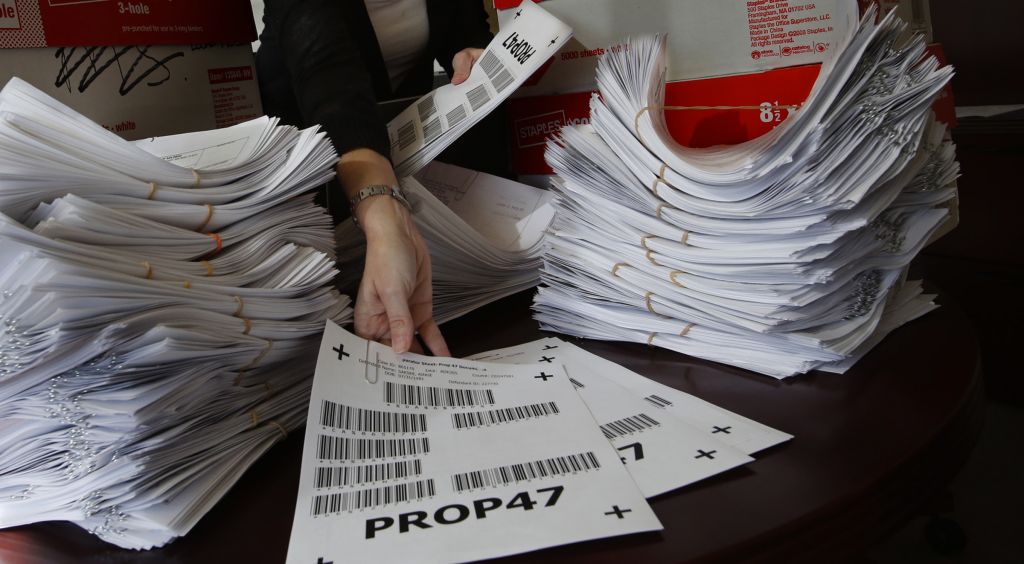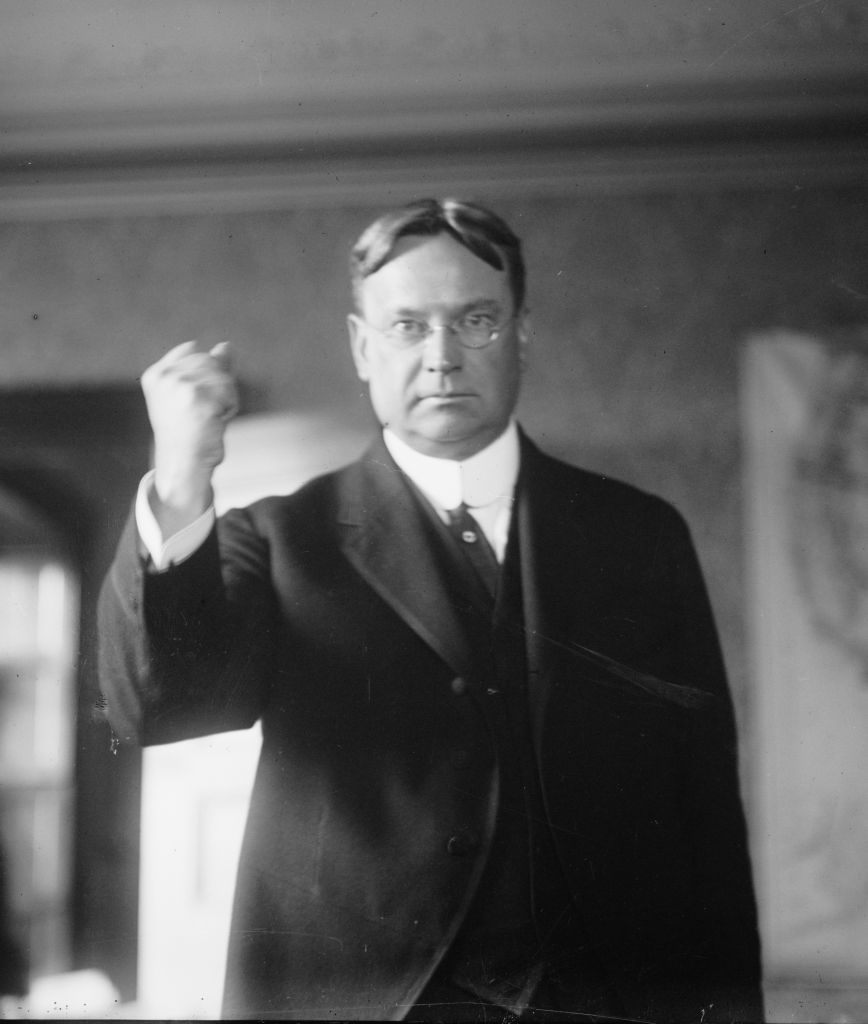
A reader, Mary Ellen Quinn, asks: “Why does a state like California have so many ballot initiatives and referenda? Could any one of them throw that state into turmoil the way the Brexit has rocked Britain?”
Short answer: When California voters go to the polls this November, they will have to plow through the longest, fattest ballot they have seen in almost two decades. In addition to the candidates running for office, there will be 17 ballot initiatives — or “propositions,” as California refers to them — for voters to consider. Overwhelmed voters can blame nonvoters, in part, for the time they will spend poring over the proposed policies. That’s because the number of signatures necessary to introduce an initiative is a percentage of the votes cast in the last gubernatorial election. But there are plenty of other forces at play — read on.
California’s Ballot Initiative System

The deputy district attorney with the County of San Diego with 4,800 petitions for Proposition 47, which addresses criminal sentencing. (Photo by Don Bartletti/Los Angeles Times via Getty Images)
In California, each proposed measure must address only one subject. And the number of signatures needed to place an initiative on the ballot is calculated as a percentage of the people who voted in the last election for governor: 8 percent for a constitutional amendment and 5 percent for proposing a law or a veto. Because turnout in 2014 reached a record low, it became easier to put proposals on the ballot for 2016.
But don’t expect a “Caliexit” any time soon. It goes against the United States Constitution for a state to withdraw, and civil war is not on California’s sunny horizon. A few years back, there was an initiative to chop the state into “Six Californias” but it never earned the signatures necessary for final consideration.
That said, California voters have been known to get on board with dramatic new policies. In 1978 nearly two-thirds of California’s voters passed Proposition 13 which reduced property taxes by about 57 percent. And in 2003 Californians famously held a referendum to recall Gov. Gray Davis, leading to the election of Arnold Schwarzenegger.
Regarding Referendums
Putting policy questions to the popular vote, in the form of referenda and ballot initiatives, goes back to ancient Rome. A Roman named Tacitus wrote “On matters of minor importance only the chiefs decide; on major matters the whole community decides.”
Today, 24 states and Washington, DC allow citizens to change state law or the state constitution by gathering the required number of signatures to put an initiative on the ballot. There is a national uptick in proposed measures this year, according to Ballotpedia, which tracks federal, state and local elections. In addition to lower thresholds for signatures in some states, such as California, presidential election years often see more ballot measures, and Jennie Bowser, who studied ballot initiatives for the National Conference of State Legislatures, says she has also noticed that ballot initiatives are becoming more and more common in recent years.

Hiram Johnson, governor of California from 1911-17. (Library of Congress)
The practice in California began in 1911 when Gov. Hiram Johnson pushed for constitutional amendments to give citizens a more powerful voice and a way to bypass the legislature. A progressive, Johnson hoped to curb the influence of the corrupt politicians who were beholden to the powerful railroad companies. Today, it seems, his mission has backfired. Wealthy interests are back in the driver’s seat, steering outrageous sums of money into campaigns meant to influence the outcome of the vote on ballot initiatives that would help corporate bottom lines. This year, some political consultants think the money pouring into California’s ballot initiative industry will top $400 million. And there is no Hiram Johnson plugging for reform. Nonetheless, particularly in western states like California, Oregon, Colorado and Washington, says Bowser, “it is accepted that the initiative is a vibrant part of the political and lawmaking process.”
Electoral Industrial Complex
Ballot initiatives have spawned an entire industry. It is increasingly rare to find volunteers wielding clipboards at shopping malls. Signature gathering firms now pay hired guns anywhere from $2 to $5 for every name that they score. In fact, when the California deadline was extended this year, lengthening the amount of time ballot initiative backers had to harvest signatures, it delayed the migration of the professional signature gatherers to Washington State — leaving some campaigns there scrambling at the last minute to meet the filing deadline. Professionals also draft the proposals, hold the focus groups, fight for the title and summary language and produce the advertising. “It’s no longer the grassroots, volunteer populism that people tend to think it is,” says Bowser.
Fat Cats with Causes
Behind many propositions there are crusading fat cats fighting for a cause. In California, billionaire activist Tom Steyer is backing Proposition 56, a $2-per-pack cigarette tax; Lt. Gov. Gavin Newsom is putting his weight behind Proposition 63, a gun control measure; and Napster founder Sean Parker is putting almost $3 million into Proposition 64, the marijuana legalization initiative. Proposition 60, a law that makes adult-film actors wear condoms during sex, is backed by a wealthy Los Angeles resident, Michael Weinstein, whose health care foundation has a $1.3 billion budget. Weinstein is also sponsoring Proposition 61 to cap the amount that state agencies pay for drugs.
Then there are the deep-pocketed corporate opponents. The Pharmaceutical Research and Manufacturers of America (PhRMA), a trade group, has already raised $70 million to try to kill Weinstein’s drug cap. Meanwhile, The American Progressive Bag Alliance, a group of plastics manufacturers, has spent nearly $6 million to trigger a referendum on California’s plastic bag ban.
While it may cost more to make policy through the ballot initiative process, corporations find it easier than lobbying. “You don’t have to build coalitions, you don’t have to compromise, and you can draft the proposition exactly how you want it,” says Bowser, “with a whole lot of organization and money, and a certain amount of luck, you can get it passed.”
The Wild West of Money in Politics
There are no limits, in any states, on how much individuals or corporations can contribute to a ballot issue campaign, or how much the campaign can spend. The Supreme Court has ruled that business interests, labor unions and individuals with causes have a First Amendment right to spend what they like on state and local ballot measures. “That leaves states with disclosure rules,” says Bowser, “and states disclose to wildly different degrees.”
Lessons from Brexit
In the aftermath of the Brexit, the takeaway for Bowser was that many people were poorly informed. They cast their votes, without really knowing what the consequences would be. That should be a concern in the United States as well, she says. “Who reads that big pamphlet the size of a phone book that arrives two to three weeks before an election? I suspect many people do not.” When a proposition is passed in states like California it becomes binding law immediately, unless it is, potentially, unconstitutional, in which case it goes to court. “It is much healthier for our democracy,” Bowser says, “if people take a more critical look beforehand.”




